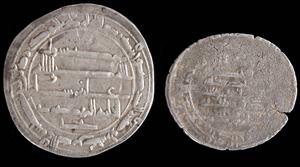M.b. Reilly / University of Cincinnati
Source - http://phys.org/news/2013-01-unveils-medieval-cultures-islam.html#jCp

The medieval coin at left, minted in the Islamic center of Baghdad, bears two names. The one at right, minted at Isfahan, Iran, bears a total of five names, reflecting more complex political networks further away from the capital.
Medieval Afghanistan, Iran and the one-time Soviet Central Asian states were frontiers in flux as the Islamic Caliphate spread beyond the Arabian Peninsula in the seventh through 10th centuries.
As such, different groups, such as the new Arab ruling class, the native landed gentry and local farmers, jockeyed for power, position and economic advantage over an approximately 300-year period as the Sasanian Empire collapsed and the Caliphate took its place.
University of Cincinnati historian Robert Haug, assistant professor, will present his research on how social, cultural and political changes were manifested in these border areas that serve almost as a "perpetual frontier." He does so Jan. 3, 2013, at the American Historical Association, in a presentation titled "Between the Limits and the Gaps: Conceptualizing Frontiers in Medieval Arabic and Persian Geographies."
While many in the West might perceive these Middle Eastern and Asian countries as Islamic religious monoliths, their populations in the Middle Ages were only about 50 percent Muslim in the 10th century, even after 300 years of Arab rule, according to Haug.
"Some may see these areas as homogenous today, but as the fringes of empire in the Middle Ages, there were economic, cultural, political and religious tensions that were negotiated and re-negotiated," he explained.
For instance, conversion of native populations to Islam was initially discouraged by the new Arab elite. "The incoming Arab elite seeking to solidify power in these frontier border areas wanted to maintain a distinction between themselves and the long-term resident populations. The new elites wanted to be able to collect taxes and fulfill military levies, and there were more strictures on how you went about doing so with co-religionists vs. those who were not Muslim," explained Haug, adding that radical transformation and conversions did not generally take place except at the very top tier of native societies.
In studying records of the era, he also finds how subject populations maneuvered in order to maintain position, economic security or cultural identity in a shifting social climate. For instance, in comparing early ninth century records and texts to those from the late 10th centuries, Haug notes that as the number of mosques in an area increased, the vocabulary for referring to fortified farms also changed.
These were border areas on the edge of the steppes where raiders were a perpetual problem, so farmers and landed gentry wanted to keep their fortified grain silos and farms. However, these fortified enclosures were also seen as a threat by the Caliphate. After all, they could serve to harbor enemies of the Islamic empire. To negotiate this tightrope, village headmen, farmers and the landed gentry began to refer to these defensive enclosures as "ribats," which was not the former local word used, but an Arab term referencing a defensive jihad. So, now, the fortified farms and food storage could be viewed as a means for defending Islam, making them more politically and militarily acceptable to the Arab elites.
Adoption of the term doesn't mean that those using it had necessarily converted to Islam, said Haug, adding, "This had become a mixed culture with overlapping identities. Political and economic necessity likely drove such changes in the vocabulary and culture. It's not unlike how Michigan residents or Minnesotans tend to watch hockey, thus aligning themselves culturally with Canada in this regard; however, they're still U.S. citizens."
The coins minted and used in the frontier areas also speak of the struggle of local elites to retain or expand their power under the Caliphate. "The coins give you information as to who was in charge. I also like to say, 'The coin doesn't lie.' As power shifted back and forth, the names on the coins change," said Haug.
For instance, coins minted and used in Baghdad might have three names on them, that of the Caliph, his heir and the area's governor perhaps. Coins in the frontier areas could have a half dozen or so names inscribed. "On the frontier, the coin minters were hedging their bets. Power could change hands along the border, and the coins represent how often and easily that happened. In fact, names on coins minted in frontier areas changed with much greater frequency than did those on coins minted in Baghdad or other centrally located mints," stated Haug.
More information: aha.confex.com/aha/2013/webprogram/Paper11844.html